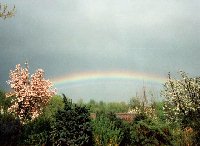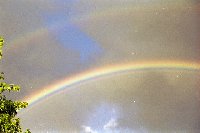




Rainbows are probably the most common atmospheric phenomenon. Everybody has seen it, but in most cases by chance. The one who wants to hunt rainbows, must know the conditions under which a rainbow appears and has to know at which position in the sky he or she has to look for it.
A rainbow is part of an arc with a radius of 42� around the antisolar point. Its outer rim is red. This is followed by orange, yellow, green, blue and violet with fluent shadings. A rainbow is only visible when the sun shines while it is raining. Furthermore, the sun elevation has to be less than 42�. If the sun is higher, the antisolar point is more than 42� below the horizon, so that the rainbow does not get above the horizon. In our region, the sun can reach an elevation of about 60� in summer. That is why you will never see a rainbow around noon in summer. So the best conditions for observations are given in the morning and in the evening, when rainbows are especially high above the horizon. On the contrary, sun elevation is never higher than 42� in winter, so that a rainbow can appear during the whole day. In general one can say that the lower the sun is in the sky, the higher is the rainbow. If the sun elevation is higher than 42�, the primary rainbow is not visible any more.
Real "rainbow weather" comes up when a cold front approaches. Then frequent showers form with sunny spells in between (April weather). After a thundershower in summer the sky also becomes clear again very fast, so that one can reckon with a rainbow. Especially good conditions are given in the late afternoon. Then the sun is so low that it cannot be covered by the last clouds overhead the observer. Furthermore, it rains more often. in the evenings than it does in the mornings. So, most rainbows by far are observed during the hours before sunset.
When the preconditions for the appearing of a rainbow are realized, one also has to know where the rainbow appears. To find it, he or she has to know that the top of the rainbow is always visible exactly opposite the sun. When you think that there could be a rainbow in the sky, just look at the direction where your shadow is. In this direction you can find the top of the rainbow. The lower the sun is in the sky, the higher is the top of the rainbow. On its right and on its left you can see the "feet" of the rainbow. The span of the rainbow is due to the sun elevation. The lower the sun is, the wider is the rainbow. A short time before sunset the rainbow has a diameter of 84�.
In addition to the primary rainbow with a radius of 42�, there sometimes is also a secondary rainbow visible which has a radius of 51� around the antisolar point. Its sequence of colours is reversed in comparison with the primary rainbow. Sometimes one can see that the area inside the primary rainbow is brighter than the area between primary and secondary rainbow. The dark area is also called "Alexander's Dark Band". This name derives from Alexander of Aphrodisias, who lived around the year 20 Ca.C. and was a philosopher and commentator of Aristoteles. A rainbow can also be generated by moonlight. In this case, however, it is very faint.
Rainbows are caused by refraction of sunlight in raindrops. The sunlight enters the drop and then part of the light is reflected from the inner side of the drop and then leaves it whereby it gets refracted a second time. Due to the round shape of the drop, the angle of incidence of the light rays is between 0� and 10�. The increase of brightness is caused by more rays being diverged in a range between 137.5� and 138.5� (180� - 42�) than in other directions. In case of the secondary rainbow, the light is reflected from the inner side of the drop a second time before leaving it. As a great part of light leaves the drop at this position1 the secondary rainbow is significantly fainter. The sequence of colours of a rainbow is due to the refractive index of water being subject to the wavelength of the light. As we know, the white sunlight consists of light with different wavelengths. The light is then split up into its different colour components by the refraction inside the raindrop. Sometimes there are other arcs adjacent to the inner rim of the primary rainbow. These interference arcs are of a bluish or violet colour and are caused by a superimposition of waves.
The one who watches rainbows carefully, will see that they appear even more frequent than it is generally thought. But often they are faint and not visible completely.